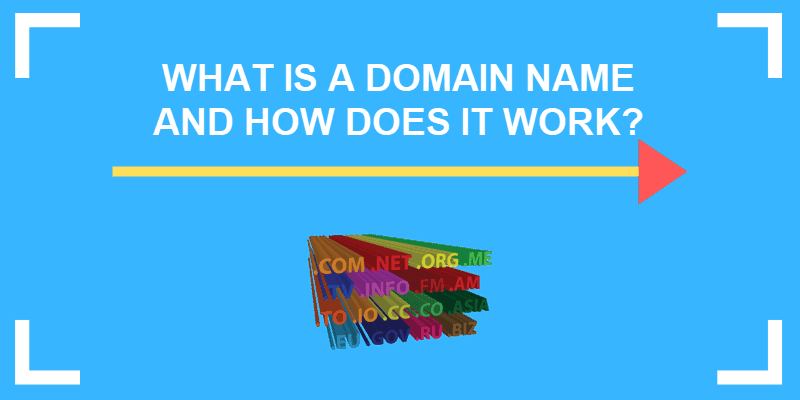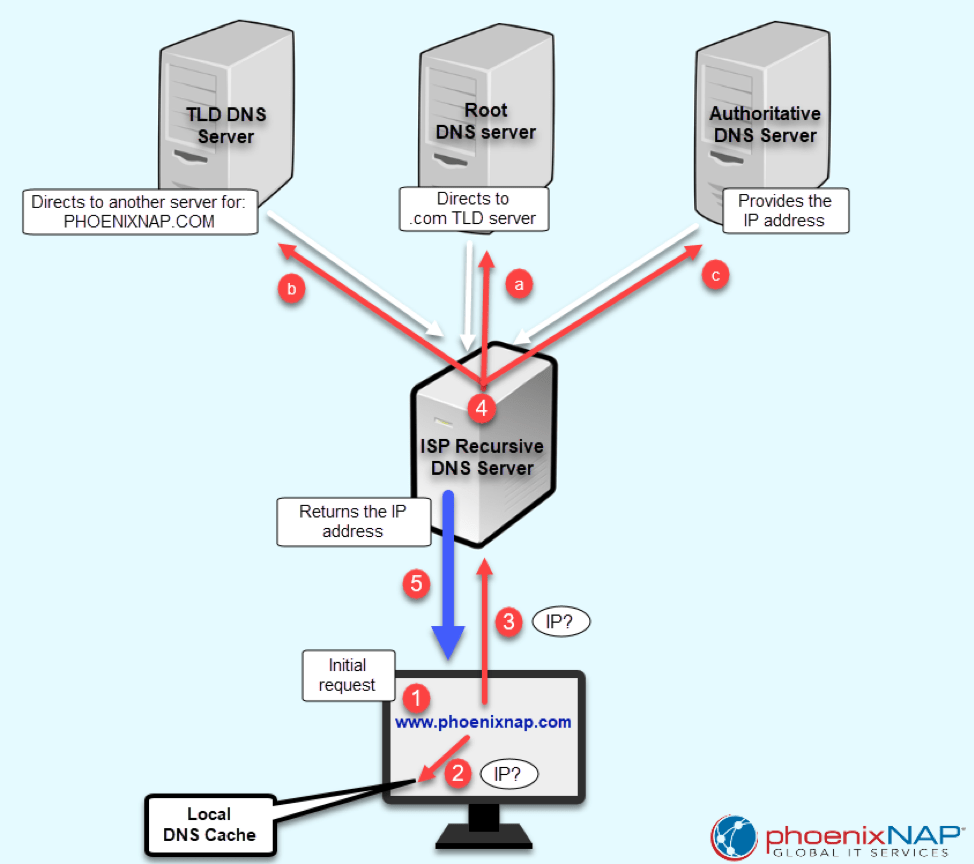What Is A Hand Registered Domain Name
What is Domain Name System or DNS?
A Domain Name System (DNS) first emerged in the early 1980s. It represents a organisation of interconnected servers that store registered domain names and Internet Protocol (IP) addresses.

As the Internet grew, it became an unavoidable part of online interaction. The majority of internet users are not even aware of DNS and the huge favor information technology does united states of america. Without DNS, you cannot admission any website by typing a URL in your browser.
Computers talk to each other using IP addresses. Since humans cannot memorize thousands of strings of numbers, nosotros have to use domain names instead of IP addresses. It is much easier to remember to type phoenixnap.com into your browser than 198.24.170.115.
When y'all want to visit a website, your calculator needs to know the exact IP address; it does non care about the domain name.
DNS keeps the record of all domain names and the associated IP addresses. When you type in a URL in your browser, DNS resolves the domain proper name into an IP address.
In other words, DNS is a service that maps domain names to corresponding IP addresses.
How Does DNS Work?
DNS is at the core of the Internet we use today.
The latest report shows in that location were 342.4 1000000 domain names in the 3rd quarter of 2018 and we would take been lost without DNS to resolve them into IP address.
When you desire to call someone using your cell phone, information technology is highly unlikely you punch in the exact phone number. Instead, you load the contact list and search using the person's name. DNS does the same thing when you desire to load a website.
Resolving a domain name or a hostname goes through several unlike phases.
On some occasions, DNS resolving is a 1-step process, while on the other information technology involves contacting multiple DNS servers. The diagram below shows the necessary steps in this process and does not take into account the browser cache.

Why is DNS Cached?
DNS caching or flushing is an effective way to reduce potential DNS queries towards DNS nameservers. This speeds up the domain name resolving procedure.
Caching happens at multiple locations. This includes your calculator, sometimes routers, while all DNS servers have their ain databases with cached information.
Stride 1 – Send a Request to Resolve a Domain Proper name
When you type world wide web.phoenixnap.com into a browser, in society to load the webpage, your computer asks for the IP address. Computers do non know in advance where they can discover the necessary data, so they endeavour searching through the DNS cache and any available external source.
Step 2 – Search for an IP Locally
Before going externally, your computer loads the local DNS cache database to meet if you lot already requested the IP for that domain proper noun. Every computer has a temporary cache with the nearly contempo DNS requests and attempts to connect to online sources.
When the DNS cache has the IP information for the website that you are trying to connect to, the page loads immediately. DNS enshroud expedites this lookup process since the computer contains the information information technology needs and does non accept to forward the request to your Internet service provider.
Stride iii – Contact ISP and its Recursive DNS Server to Resolve a Domain Name
A estimator's local DNS cache database does not always contain the necessary information to resolve a domain name. In that instance, the asking goes farther to your Internet access provider (ISP) and its DNS server.
Once it gets a request, the resolver looks in its records to provide the correct IP address. When the necessary data is present in the Isp server'due south buried records, the reckoner gets back the IP and connects to the website. If ISP's recursive DNS server cannot resolve the domain name, it contacts other DNS servers to provide the information back to you. This is why nosotros phone call them recursive servers. Every Cyberspace Service Provider has at to the lowest degree a secondary DNS server setup to ensure maximum loftier availability of the service.
Step 4 – Ask Outside DNS Servers to Provide an IP Address
Internet service provider DNS resolvers are configured to enquire other DNS servers for correct IP address mapping until they can provide information back to the requester. These are iterative DNS queries.
When a DNS client sends such a request, the first responding server does not provide the needed IP address. Instead, it directs the request to some other server that is lower in the DNS hierarchy, and that 1 to another until the IP address is fully resolved. There are a few stops in this process.
- Root domain nameservers. Root servers themselves do not map IP addresses to domain names. Instead, they hold the data about all top-level domain (TLD) nameservers and point to their location. TLD is the rightmost section of a domain name, for example, .com in
phoenixnap.comor .org inwww.technology.org. Root servers are disquisitional since they are the showtime finish for all DNS lookup requests. - TLD nameservers. These servers contain the data for second-level domains, such as 'phoenixnap' in
phoenixnap.com. Previously, the root server pointed to the location of the TLD server. Then, the TLD server needs to direct the request toward the server that contains the necessary data for the website we are trying to reach. - Authoritative nameserver. Authoritative servers are the final destination for DNS lookup requests. They provide the website's IP address dorsum to the recursive DNS servers. If the site has subdomains, the local DNS server will keep sending requests to the administrative server until it finally resolves the IP address.
Stride 5 – Receive the IP Accost
In one case the ISP's recursive DNS server obtains the IP address by sending multiple iterative DNS queries, it finally returns it to your estimator. The record for this request now stays cached on the hard bulldoze. The browser can then fetch this IP from the enshroud and connect it to the website'due south server.
When we interruption it downwards like this, the process of DNS lookup seems to take a long time to complete. In fact, it takes milliseconds, with peradventure a few milliseconds more than if the DNS record is not in the local cache. In both cases, users cannot tell the difference. This is a basic description of how DNS works, and it should requite you an idea what goes on under the hood when you browse or send an email.
Conclusion
This article has explained what a Domain Proper noun Arrangement is and how it works. It covered the essential DNS functions and what needs to happen before you tin connect to an online server using its domain proper noun.
Was this article helpful?
Yes No
Source: https://phoenixnap.com/kb/what-is-domain-name-system-works
Posted by: longwiself.blogspot.com


0 Response to "What Is A Hand Registered Domain Name"
Post a Comment